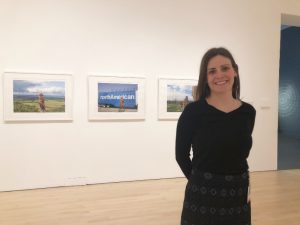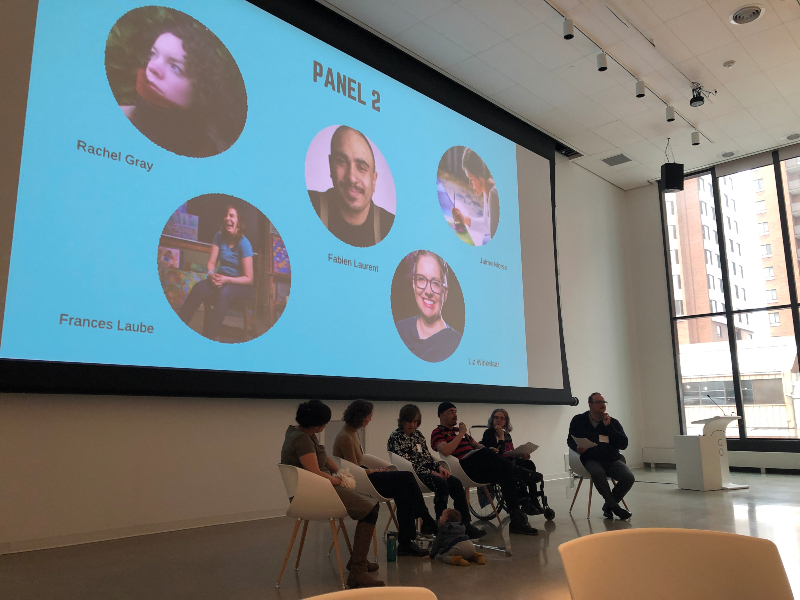Curating living cultures

Jasmine Inglis stands in front of portraits by Iroquois artist Jeff Thomas. [Photo © Jennifer Liu]
As a curatorial assistant of Indigenous visual art, Jasmine Inglis has input into what works are displayed for the general public to see.
“Indigenous people don’t want to be pigeon-holed into only doing historical things in a contemporary time,” Inglis says. “Indigenous artists are like any other contemporary artist: they want to be recognized for their work as an individual, not just because they’re Indigenous.”
At the National Gallery of Canada – where Inglis works – she helped select the series of four portraits by photo-based Indigenous storyteller Jeff Thomas. They are the face of the National Gallery’s most recent installation, featuring winners of the 2019 Governor General Awards in Visual and Media Arts.
Inglis says that an ongoing issue in Indigenous arts circles is that non-Indigenous visitors seek art that they perceive as being authentically Indigenous. Northwest coast art – totem poles and ovoids come to mind – are linked with non-White art. Inglis says stereotypes still need to be broken down between audience impressions of Indigenous art, and current realities.
“There is still an older generation that has a problem seeing contemporary work by Indigenous artists and accepting it as they want to see something else,” Inglis says. “That is no longer a reality, that’s in the past.”
That said, audiences have grown more open-minded of Indigenous art’s coverage progressively since the ’60s. At the National Gallery, Inuit art started being collected in 1956 and contemporary Indigenous art in 1986. The Gallery’s mandate corresponds with Call to Action No. 79 of the Truth and Reconciliation Commission Report: that of the integration of “Indigenous history, heritage values, and memory practices into Canada’s national heritage and history.”
Inglis says the National Gallery’s mandate is “certainly not” to portray Indigenous art in an exotic light, or even as being labelled as “Indigenous” separate from the Gallery’s other collections. Instead, the intention is to showcase Indigenous art in the context of a general contemporary practice and movement. “I definitely think of it as: our goal as curators is to highlight work for the work itself, not for the indigeneity of it,” Inglis says. She stops short of calling it a battle to bring understanding to a piece: for one, the 60-character limits on labels make it difficult to convey conceptual ideas.
Each piece of art demands a different relationship between its creator and the viewer. Different artists reveal different amounts of cues to bring the viewer into their cultural world: Inglis says some are didactic and like to explain concepts, while others want the viewer to see the work as it appears. Some people have more knowledge of the subject, others may interpret abstract concepts from a work: “It really depends on the viewer and on what the artist is willing to offer,” Inglis says.
“I think it’s a great time for the museum world and for historically marginalized artists,” Inglis says. “Especially in the art world, there’s lots of moves forward to be more inclusive and to change historical modes of display that have been ruling for 40, 50 years.”

Jaime Morse, seated at the far left, participates in the the Social Responsibility in the Heritage Sector symposium in Ottawa on March 30, 2019. [Photo © Jennifer Liu]
But Jaime Morse (née Koebel), an Indigenous staff member at the National Gallery, is underwhelmed by the Gallery’s efforts to uphold Indigenous culture.
Morse is an Otipemsiwak/Nehiyaw (Métis/Cree) woman who moved to Ottawa from Lac La Biche, Alberta in 2000 as a 15-year-old. She an educator in the National Gallery of Canada’s Indigenous Programs and Outreach department. She is also the founder of Indigenous Walks, an Ottawa walking tour that takes participants to monuments that are significant to Indigenous history.
However, she is contemplating leaving her position in protest. She says 98.5 per cent of the staff are non-Indigenous at the institution, and says the Gallery should put in resources to hire somebody to promote positive relations between Indigenous groups.
“I’m here to educate the public, but my job has turned into educating everyone else around me who is not Indigenous,” Morse says.
Morse acknowledges that in Ottawa, she has seen a difference in Indigenous inclusion, citing Indigenous displays at the Canada Space and Technology Museum and the Canada Aviation and Space Museum. “But it’s like, this big compared to their whole space,” Morse gestures at the width of her body. “But I still feel that as an Indigenous person in our society, they should be given more space. The changes are really small, and that’s just on the surface – somebody might go into a gallery and be like, ‘Wow, they did this! Good for you, museum, this was never here before!’ ” Morse says.
She has come to question the museological perspective in this time of renewed interest in art’s role in reconciliation with Indigenous Peoples.
Morse recalls a quote from the 2018 CBC Massey Lectures by Sen. Murray Sinclair, Chief Commissioner of the Truth and Reconciliation Commission. “He said, ‘If we’re waiting for institutions or these governments…to stop doing what they’re doing for us to heal, basically it will never happen,’ ” Morse says. That shook her sense of security around benefits, a nine-to-five job and regular pay. “The reason we’re still here as Indigenous Peoples is because our people have done what they’ve always done for thousands of years. I don’t want to lose that knowledge.”
As for guiding people from a dominant culture to shed their inherent expectations of other cultures’ art, she has stopped trying to figure that question out. “Because I want to figure out how I can pick up art and traditional knowledge, and I don’t care what the dominant culture is anymore.”

Stacy Douglas joined the Carleton University Department of Law and Legal Studies in 2012. (Photo courtesy of Carleton University)
In her recent book, Curating Community: Museums, Constitutionalism, and the Taming of the Political, Carleton University associate professor Stacy Douglas argues that so long as museological institutions exist, old-fashioned ideals of art will persist, which sets up a hierarchical complex.
For Douglas, who teaches in the department of law and legal studies, her view hinges on three tenets: that museological representations are limited in scale; that an underlying European aesthetic lends a performative quality to exhibits, and that the goal-oriented impetus to Western lifestyles hinders any anti-colonial movements.
To explain how Indigenous rights may be ascertained, Douglas cites Janet Marstine, a specialist in museum ethics: museums must be converted “from a site of worship and awe to one of discourse and critical reflection that is committed to examining unsettling histories with sensitivity to all parties…New museum theory is about decolonizing, giving those represented control of their own cultural heritage.”
Ming Tiampo is an art history professor and director of the Institute for Comparative Studies in Literature, Art and Culture at Carleton University. She takes particular interest in museum curation and disrupting old standards of appraising art.
“It shouldn’t be about those labelled communities – it should be much more about decolonizing our structures,” Tiampo says. Further, she argues that the conventional model hinders the fusional process of reconciliation. “It’s creating divisions between communities and asking people to identify solely with a particular identity group that has been identified as being a priority, or not a priority,” she says.
“Indigenous…art history cannot avoid the realm of the anthropologist – the museum. Many art works from the history period are in museum collections with little or no provenance, organized by object type or regional categories. These persistent generic identifications, combined with a generic lack of specific information, effectively erase the human maker.”
“I’ve been at the Gallery since 2013 and I’m questioning my impact at the Gallery and whether that’s where I want to put my energy. So in one hand, I think that’s great but at a deep level they’re not going to change and I feel like I’m wasting my time. That’s how I feel on my low days, and I just want to go back to my community and learn all I can learn from my dad who lives off the land and fishes, and teach my kids and my people, and that’s where I think real reconciliation can happen. But I’m losing that faith that that can happen, within an institution it’s not inherently possible.”